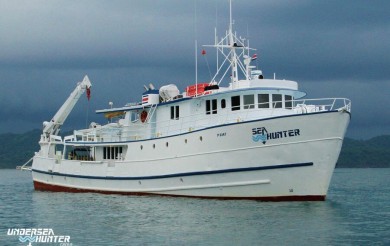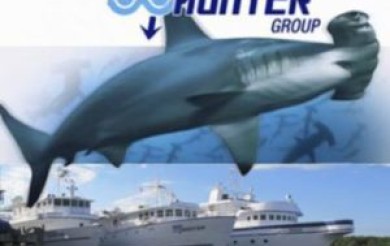Porcupine Fish – Our Spiny Friends
When you go diving in Cocos Island and see this oddly-looking fish that has a round and elongated body with long spines scattered all over, then most probably you have seen a porcupinefish. Often found in rocky crevices and sandy bottom, this fish will always give you an impression that they are smiling at you where you will further learn that each species will impress you with its own and unique quality of smile.
Similarities and Differences between Porcupinefish and Pufferfish
Belonging to the same Order Tetraodontiformes which means “four fused teeth” porcupinefish and pufferfish have a lot in common. First, both of them have the ability to inflate themselves when threatened or provoked. Second, they have a dental system that is fused forming like a solid beak which is designed to crash shelled invertebrates like mollusk and crustaceans. But what really stands out in their similarity is the accumulation of toxin inside their body which makes both of them poisonous to eat.
As far as their differences is concerned, we can focus on the description of their scales. Pufferfish are not entirely covered with scales where each of the scales may only possess short spines. Porcupinefish, on the other hand, are entirely covered with scales the is equipped with long and retractable spines. Another difference that can be pointed out has something to do with the reason why they bloat themselves. For the porcupinefish, they do it instantly for defense while pufferfish only bloats themselves as a last recourse for defense where they tend to first hide in rocks and crevices.
Species of Porcupinefish in Cocos Island
As you proceed with the different species of porcupinefish in Cocos island, you will notice that the pictures we presented are specimens that are in their normal state and not bloated. The reason for this is that you will usually encounter a relaxed and calm porcupinefish in Cocos Island where they always welcome our presence underwater with a smile, not unless you threaten or provoke them. Here are the different species of porcupinefish found in Cocos Island.
Spotfin Burrfish (Chilomycterus reticulatus)
Other Name: Few-spined Porcupinefish
Max. Length: 69.7 centimeters
Length at 1st Maturity: 38.9 centimeters
a value:
b value:
Depth Range: 20 – 100 meters (60 – 300 feet)
Frequency: Abundant in the world’s tropical coral reefs
When you go diving in Cocos Island and see a spotfin burrfish, it will give you an impression that this fish is smiling at you. In reality, they’re not. This false grin is due to their large mouth with a fused teeth with no frontal groove on its lips. Aside from their nice and pleasing smile, you can easily identify them through their round, elongated and inflatable body that is usually colored brown-grey and has a black angular bands with black spots that may cover up to its belly. Their heads have a blunt shape while their eyes are relatively large. In an adult spotfin burrfish, their nose looks like an open-pit cup while the nasal organs of their juveniles comes in a tentacle protrusion with two nasal slits at the end.
For more information, you can read our related article about Spotfin Burrfish.
Longspined Porcupinefish (Diodon holocanthus)
Other Name: Freckled Porcupinefish
Max. Length: 50 centimeters
Length at 1st Maturity: 15.4 centimeters
a value: 0.11900
b value: 2.630
Depth Range: 2 – 200 meters (6 – 600 feet)
Frequency: Abundant in the world’s tropical coral reefs
If we speak of grin quality, a longspined porcupinefish has a better smile compared to a spotfin burrfish. Aside from their pleasing look which you will often notice, you can easily identify a longspined porcupinefish through its pale colored body that is equipped with long and contractible spines especially on its head.
As far as the longspined porcupinefish is concerned, you can tell their age according to the size of the black dots scattered in their body. When it is still a juvenile, there are many black spots that are usually big in size and this subsides, both in size and quantity, as they grow old.
For more information, you can read our related article about Longspined Porcupinefish.
Spot-fin Porcupinefish (Diodon hystrix)
Other Name: Black-spotted Porcupinefish
Max. Length: 91 centimeters
Length at 1st Maturity: 49.3 centimeters
a value: 0.53200
b value: 2.276
Depth Range: 2 – 50 meters (6 – 150 feet)
Frequency: Abundant in the world’s tropical coral reefs
This medium-sized porcupinefish has one of the cutest smiles where you can often see them in the rocky reef areas of Cocos Island. This cute smile is made possible through its spherical head with big round protruding eyes and a beaked mouth that is usually open.
Aside from grin quality, you can easily identify them through their beige to sandy-yellow marble colored body that is filled with several small dark spots. If only you are allowed to touch a spot-fin porcupinefish, you will be amazed that their skin is relatively smooth despite the presence of spikes or thorns.
For more information, you can read our related article about Spot-fin Porcupinefish.
Poisonous to Eat
As the saying goes “there’s always something behind a smile”, and yes, there’s something behind a porcupinefish smile. If you eat porcupinefish, you will definitely be missing your underwater adventures in Cocos Island as the consequence of eating this poisonous fish can be six feet under the ground. Their bodies contain high levels of poison called tetrodotoxin (TTX) which is a powerful neurotoxin and can cause death within hours after consumption.
Homer Simpson Eats Blowfish
So do not take the risk and eat other seafoods that are safer and delicious. In that way, your fun and enjoyment in Cocos Island is guaranteed to continue.
Reference
Fishbase: www.fishbase.org
IUCN Redlist of Threatened Species: www.iucnredlist.org
Encyclopedia of Life: www.eol.org
Video courtesy from Core Sea
Cocos Island Liveaboard Trips for 2019
Due to high demand of liveaboard trips to Cocos island, as early as this year, we are publishing the 2019 trips for you to choose your preferred schedule and prepare for the ultimate diving adventure of your life. Reserve your seat to Cocos Island as they are selling like hotcakes. Schedule of Liveaboard Trip to […]


















